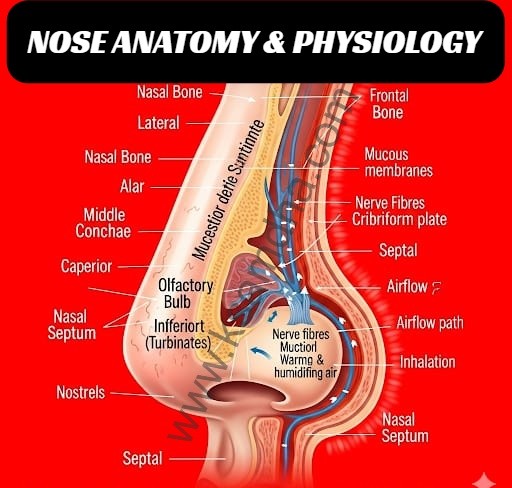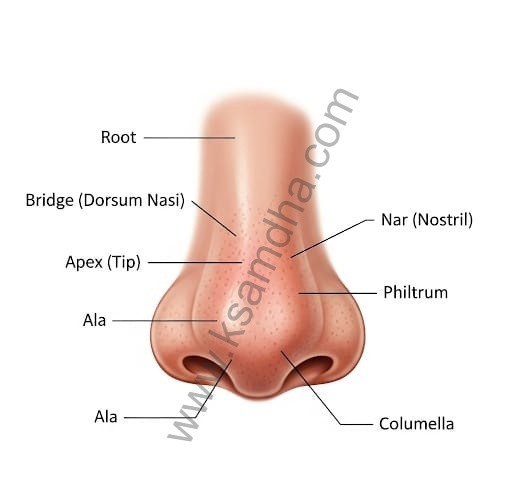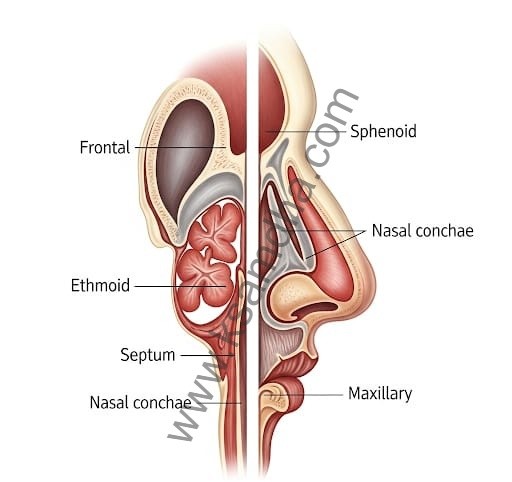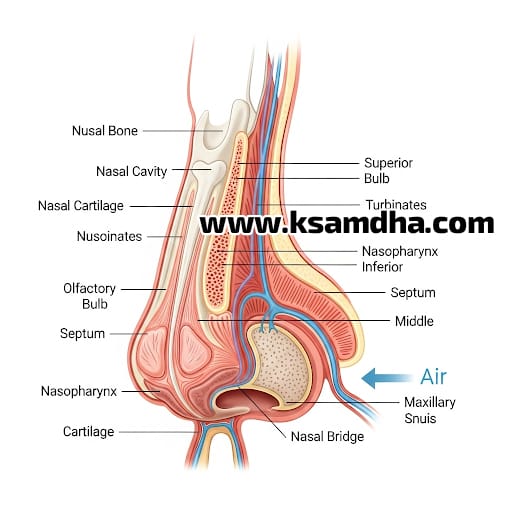Introduction to the Nose

The nose is one of the most important organs of the human body, serving as the primary passageway for air during breathing and playing a key role in the sense of smell. It also contributes to voice resonance and acts as a defense mechanism by filtering, warming, and humidifying the air before it reaches the lungs. Understanding the anatomy and physiology of the nose is crucial for medical students, healthcare professionals, and anyone interested in human biology. Nose Anatomy and Physiology
The nose is a prominent structure of the face that forms the initial part of the respiratory tract. It can be divided into:
1 – External nose – the visible part on the face.
2 – Nasal cavity – the internal space inside the skull, lined with mucosa, that connects with the throat.
Anatomy of the Nose
1 – External Nose

The external nose is the visible structure located in the center of the face. Its shape and size vary among individuals due to genetic and ethnic differences. It is made of:
- Root – where the nose joins the forehead.
- Bridge – upper portion formed mainly by the nasal bones.
- Dorsum – length of the nose extending down to the tip.
- Apex – the tip of the nose.
- Nostrils (nares) – external openings that lead into the nasal cavity.
- Alae – the fleshy, curved sides of the nose around the nostrils.
- The external framework is formed by:
- Bone: nasal bones, frontal bone, and maxilla.
- Cartilage: lateral, alar, and septal cartilages.
- Skin and soft tissue that cover the surface.
2 – Nasal Cavity
The nasal cavity is the internal chamber of the nose. It is divided into right and left halves by the nasal septum, which is partly bony and partly cartilaginous. Each half of the nasal cavity has:
- Roof – formed by the cribriform plate of the ethmoid bone.
- Floor – formed by the hard palate (maxilla and palatine bones).
- Lateral walls – irregular due to bony projections called turbinates (superior, middle, and inferior conchae).
- Meatuses – spaces under the conchae where the paranasal sinuses and nasolacrimal duct open.
- Subdivisions of Nasal Cavity:
- Vestibule – the front part lined by skin and hairs (vibrissae) to trap dust.
- Respiratory region – lined by respiratory epithelium (ciliated pseudostratified columnar epithelium with goblet cells).
- Olfactory region – located at the roof, lined with olfactory epithelium for smell perception.
3 – Nasal Septum
- The nasal septum separates the two nasal cavities. It is composed of:
- Perpendicular plate of the ethmoid bone (superior).
- Vomer bone (posterior-inferior).
- Septal cartilage (anterior).
- A deviated septum can cause breathing difficulties and is a common clinical problem.
4 – Paranasal Sinuses

- The paranasal sinuses are air-filled spaces within certain skull bones, connected to the nasal cavity. They include:
- Frontal sinus (in frontal bone).
- Maxillary sinus (in maxilla, the largest sinus).
- Ethmoidal sinuses (in ethmoid bone).
- Sphenoidal sinus (in sphenoid bone).
- Functions of sinuses include lightening the skull, warming and humidifying air, resonance for voice, and reducing impact from trauma.
5 – Blood Supply of Nose
- The nose has a rich blood supply from both internal and external carotid arteries:
- Anterior and posterior ethmoidal arteries (ophthalmic branch).
- Sphenopalatine artery (maxillary branch).
- Superior labial artery (facial branch).
- The Kiesselbach’s plexus (Little’s area) is a common site of nosebleeds (epistaxis).
6 – Nerve Supply
- Olfactory nerve (CN I): sense of smell.
- Trigeminal nerve (CN V): general sensation; ophthalmic and maxillary branches.
- Autonomic nerves: sympathetic (vasoconstriction) and parasympathetic (secretion regulation).
Physiology of the Nose

The physiology of the nose can be understood through its functions:
1 – Respiration (Air Passage)
- The nose is the primary entry point for inspired air. As air passes through, it is:
- Filtered – by nasal hairs and mucous to remove dust, bacteria, and pollutants.
- Warmed – due to rich blood supply.
- Humidified – by mucous secretions, preventing dryness in lower airways.
- This process ensures that the lungs receive clean, moist, and warm air, reducing the risk of infections.
2 – Olfaction (Sense of Smell)
The upper part of the nasal cavity contains olfactory epithelium, which has specialized receptor cells. These cells detect odor molecules and send signals through the olfactory nerve to the brain, where smells are identified. Smell also influences taste, emotions, and memory.
3 – Protection and Defense
- The nose acts as the first line of defense in the respiratory system. Protective mechanisms include:
- Vibrissae (hairs) – trap large particles.
- Mucociliary clearance – cilia sweep mucus and trapped particles toward the throat, where they are swallowed.
- Sneezing reflex – expels irritants.
- Immune defense – nasal mucosa contains immune cells and secretory IgA.
4 – Resonance of Voice
The nasal cavity and sinuses act as resonating chambers that modify and amplify voice. This is why nasal obstruction (e.g., during a cold) changes voice quality.
5 – Drainage of Secretions
- The nasal cavity ensures proper drainage of mucus and tears:
- Mucus from nasal glands and goblet cells drains posteriorly into the pharynx.
- Tears drain via the nasolacrimal duct into the inferior meatus, preventing eye overflow.
FUNCTION OF THE NOSE
Major Functions of the Nose
The nose performs multiple interconnected functions that are essential for survival. These can be categorized into respiratory, protective, sensory, and structural functions.
1 – Breathing and Air Passage
- The primary function of the nose is to act as the main entry point for air into the respiratory system. When we breathe through the nose, air passes through the nostrils, nasal cavity, pharynx, larynx, and eventually into the lungs.
- Breathing through the nose is healthier than mouth breathing because the nose filters and conditions the air before it reaches the lungs.
- Proper nasal breathing also regulates airflow, ensuring smooth oxygen exchange in the lungs.
2 – Filtering of Air
- One of the most important protective roles of the nose is to filter harmful particles from the air we inhale.
- The nasal hairs (vibrissae) trap larger particles such as dust, pollen, and insects.
- The mucus lining of the nasal cavity captures smaller particles, bacteria, and viruses.
- The cilia move the trapped particles toward the throat, where they are either coughed out or swallowed and destroyed by stomach acid.
- This filtering mechanism acts as a first line of defense against respiratory infections and environmental pollutants.
3 – Warming of Air
- The nose plays a crucial role in maintaining the right temperature of the air we breathe.
- As inhaled air passes over the turbinates, it comes in contact with a rich supply of blood vessels that warm the air to body temperature.
- This ensures that the lungs receive air that does not irritate or damage delicate lung tissues.
- This function is particularly important in cold weather, where breathing through the nose prevents the lungs from exposure to icy air.
4 – Humidification of Air
- Along with warming, the nose also adds moisture to inhaled air.
- The nasal mucosa secretes fluids that humidify the air, preventing dryness in the respiratory tract.
- Proper humidification ensures that the lungs remain moist, which is necessary for efficient gas exchange.
- Dry air can irritate the throat, trigger coughing, and worsen conditions like asthma. The nose naturally prevents these issues.
5 – Sense of Smell (Olfaction)
- The nose is the primary organ for the sense of smell.
- At the roof of the nasal cavity lies the olfactory epithelium, which contains millions of sensory receptor cells.
- These receptors detect odor molecules and send signals to the brain via the olfactory nerve.
- The brain then interprets these signals as different smells.
- The sense of smell not only enhances our experience of food and environment but also helps detect dangers like smoke, gas leaks, or spoiled food.
6 – Enhancement of Taste
- The sense of taste and smell are closely linked. The flavors we perceive in food are largely dependent on our olfactory system.
- Without the ability to smell, many foods would taste bland.
- This is why people with nasal congestion due to cold or sinusitis often complain that food has little or no flavor.
- Thus, the nose indirectly enhances our ability to enjoy and identify different foods.
7 – Immune Defense
- The nasal cavity is an important part of the body’s immune defense system.
- The mucus contains antibodies and enzymes that fight harmful microorganisms.
- Specialized immune cells in the nasal lining recognize and attack invading pathogens.
- The tonsils and adenoids, located near the nasal passages, also provide additional immune protection.
- This makes the nose a barrier organ that prevents infections from entering deeper into the respiratory system.
8 – Voice Resonance and Speech
- The nose also contributes to the quality of the human voice.
- The nasal cavity acts as a resonating chamber that amplifies and modifies sound produced in the larynx.
- Blockage of the nasal passages, such as during a cold, changes the tone of the voice and produces a nasal quality.
- Therefore, the nose indirectly plays a role in communication and speech clarity.
9 – Regulation of Air Pressure
- The nose, through its connection with the sinuses and Eustachian tubes, helps in equalizing air pressure.
- This is particularly important during altitude changes, such as flying or climbing mountains.
- Proper air pressure balance prevents discomfort and protects the eardrum.
10 – Facial Aesthetics and Identity
- While not a physiological function, the nose contributes significantly to facial appearance and identity.
- It is a central feature of the face and plays a key role in attractiveness and recognition.
- The shape and size of the nose often reflect genetic and ethnic differences.
Tips for Maintaining a Healthy Nose
- Practice regular nasal hygiene, including gentle cleaning and saline sprays.
- Stay hydrated to maintain mucus production.
- Avoid exposure to smoke, pollution, and allergens.
- Use protective masks in dusty or polluted environments.
- Seek medical help for persistent congestion, breathing difficulty, or loss of smell.
Clinical Significance of Nose Anatomy and Physiology
- Nasal obstruction – due to deviated septum, polyps, or swelling.
- Rhinitis – inflammation of nasal mucosa, often allergic or infectious.
- Sinusitis – infection or inflammation of paranasal sinuses.
- Epistaxis (nosebleeds) – common from Kiesselbach’s plexus.
- Anosmia (loss of smell) – due to trauma, viral infection, or neurological disease.
- Nasal fractures – common facial injuries.
